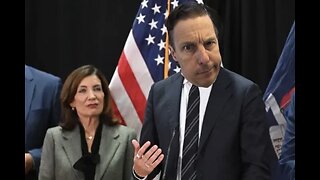Premium Only Content

What is AUSTERITY?
✪✪✪✪✪
http://www.theaudiopedia.com
✪✪✪✪✪
What is AUSTERITY? What does AUSTERITY mean? AUSTERITY meaning - AUSTERITY definition - AUSTERITY explanation. What is the meaning of AUSTERITY? What is the definition of AUSTERITY? What does AUSTERITY stand for? What is AUSTERITY meaning? What is AUSTERITY definition?
In economic policy, austerity is a set of political-economic policies that aim to reduce government budget deficits through spending cuts, tax increases, or a combination of both. There are three primary types of austerity measures: higher taxes to fund spending, raising taxes while cutting spending, and lower taxes and lower government spending. Austerity measures are often used by governments that find it difficult to borrow or meet their existing obligations to pay back loans. The measures are meant to reduce the budget deficit by bringing government revenues closer to expenditures. Proponents of these measures state that this reduces the amount of borrowing required and may also demonstrate a government's fiscal discipline to creditors and credit rating agencies and make borrowing easier and cheaper as a result.
In most macroeconomic models, austerity policies which reduce government spending lead to increased unemployment in the short term. These reductions in employment usually occur directly in the public sector and indirectly in the private sector. Where austerity policies are enacted using tax increases, these can reduce consumption by cutting household disposable income. Reduced government spending can reduce gross domestic product (GDP) growth in the short term as government expenditure is itself a component of GDP. In the longer term, reduced government spending can reduce GDP growth if, for example, cuts to education spending leave a country's workforce less able to do high-skilled jobs or if cuts to infrastructure investment impose greater costs on business than they saved through lower taxes. In both cases, if reduced government spending leads to reduced GDP growth, austerity may lead to a higher debt-to-GDP ratio than the alternative of the government running a higher budget deficit. In the aftermath of the Great Recession, austerity measures in many European countries were followed by rising unemployment and slower GDP growth. The result was increased debt-to-GDP ratios despite reductions in budget deficits.
Theoretically in some cases, particularly when the output gap is low, austerity can have the opposite effect and stimulate economic growth. For example, when an economy is operating at or near capacity, higher short-term deficit spending (stimulus) can cause interest rates to rise, resulting in a reduction in private investment, which in turn reduces economic growth. Where there is excess capacity, the stimulus can result in an increase in employment and output. Alberto Alesina, Carlo Favero, and Francesco Giavazzi argue that austerity can be expansionary in situations where government reduction in spending is offset by greater increases in aggregate demand (private consumption, private investment, and exports).
-
 1:47
1:47
The Audiopedia
1 year agoWhat is CREATIVE WRITING?
51 -
 LIVE
LIVE
GritsGG
6 hours agoQuads Win Streak Record Attempt 28/71 ! Top 70! Most Wins in WORLD! 3744+!
373 watching -
 LIVE
LIVE
Lofi Girl
2 years agoSynthwave Radio 🌌 - beats to chill/game to
133 watching -
 LIVE
LIVE
GamerGril
2 hours agoZombie Of Dreams 💞Dying Light: The Beast💞
82 watching -
 1:08:34
1:08:34
Jeff Ahern
3 hours ago $6.89 earnedThe Sunday Show with Jeff Ahern
18.6K6 -
 LIVE
LIVE
Mave12ick
2 hours ago| Ocarina of Time | Ship Of Harkinian Version | Episode I |
43 watching -
 4:41
4:41
Sean Unpaved
3 hours agoNFL Week 8 Eye Openers
14K4 -
 LIVE
LIVE
Pepkilla
1 hour agoUnlocking SMG's for BR Battlefield 6
57 watching -
 LIVE
LIVE
VapinGamers
1 hour agoTools of the Trade - EP08 - No Camera, No Problem with FatStevenJFG - !rumbot !music
57 watching -
 LIVE
LIVE
Biscotti-B23
1 hour ago🔴 LIVE MARVEL RIVALS ZOMBIES & DEAD BY DAYLIGHT 💥 MEMBERS MADNESS CONTINUES
13 watching